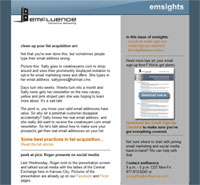 Sure, segmentation is a hot button in the email marketing world. Certainly, by now, we all know that segmenting your list increases the relevance of your emails which drives your engagement and your sales up. We know that sending relevant mail also keeps our sender reputation in good condition because users are more likely to read and less likely to mark the email as spam.
Sure, segmentation is a hot button in the email marketing world. Certainly, by now, we all know that segmenting your list increases the relevance of your emails which drives your engagement and your sales up. We know that sending relevant mail also keeps our sender reputation in good condition because users are more likely to read and less likely to mark the email as spam.
But here’s the question: how many companies actually use segmentation? According to MarketingSherpa, more than 30% of email marketers still don’t do even basic segmentation of content and offers to their email marketing subscribers. True, segmentation means you have to have data and the time to sift through it, but even basic-level segmentation is available to all email marketers. We’ve got email marketing segmentation on our Holiday Wish List this year.
As email pros and as consumers, we’d love to see our favorite companies and brands dive into segmentation. So we’ve cooked up a few suggestions for segmentation at any level.
Segmentation by Email Address Domain – What if all you have is a subscriber’s email address? That’s a start! You can segment by domain, i.e. gmail.com, aol.com, acme.com, university.edu and start to make some educated assumptions on how and when to talk to those subs. You may want to send to consumer/personal email addresses like Gmail, AOL, Hotmail, etc, on a Saturday morning for your product and send Friday at 10a to any domains that seem like they’d be corporate/business addresses. If you have domain-level reporting on past emails, you also can watch for apparently sleepy domains – no opens or clicks reported – and try sending a Text Only version of your emails to those domains.
Segmentation by Sign-Up Date – Subscribers sign up for your email list at different times for different reasons and usually based on a timely event or offer. In turn, you may be able to segment your list by how recently a subscriber signed up and make specific offers. Someone who opted in 3 years ago for information on traveling to New Orleans from the Board of Tourism may have already taken that trip, or may have never gone. Recent sign-ups may get an email that focuses on planning a trip, while older subscribers may respond better to an email asking about their favorite thing about New Orleans or reading travel blogs of other visitors on the website.
Segmentation by Location – Many email sign-up forms ask for some form of location information. Asking for city or zip, or asking subscribers to select their preferred/closest retail location can help you send location-based offers that are most relevant. For example, if you offer Broadway Theater productions at various venues across the United States, you should ask subscribers where they’re most likely to take in your shows and then send them only information about that event.
Segmentation by Email Engagement – Segmenting is most effective when it’s based on proven behaviors, meaning actions that the subscriber has taken. Those who haven’t interacted with your emails for a while may need an extra nudge or a deeper special offer to re-engage them. Those that are interacting, what do they like? When you sent an email about all-natural body soap, did they open? When you emailed subs about free shipping on their order, did they click? As our good friend and data genius Alan Weber of Data to Strategy Group (D2SG.net), likes to say, “the best predictor of future behavior is past behavior.” Use the interactions you see from your subscribers to send them tailored content that you can assume they will be more likely to open or click on in the future.
 .
. 
Segmentation by Past Purchase – If you sell online products and services, one of the best methods of segmentation you can do is by past purchase. When you can see that sally@acme.com bought thriller novels 3 times this past year, but hasn’t ever purchased a romance novel, you can target her and others whose buying habits are approximately like hers with offers and graphics centered around her genre of choice.
Not everyone has sales data to segment with. The key is to use what data you already have. You don’t necessarily have to append user data to your email list or survey your subscribers. Those are fantastic ways to get to know your list better, but you can start segmenting and targeting within your list at any time.
Once you’ve seen the results and want to segment more, try asking your new subscribers what they want to see from you when they opt-in. An important note: be sure you act on those preferences. When a consumer tells you she wants to hear about restaurants and theater and you send her all of your offers, spas, travel, etc., you’re telling her you didn’t listen.
Happy – targeted – Holidays!



